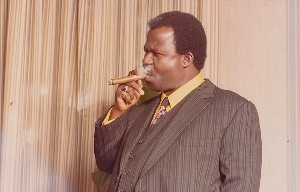- Home - News
- TWI News | TV
- Polls
- Year In Review
- News Archive
- Crime & Punishment
- Politics
- Regional
- Editorial
- Health
- Ghanaians Abroad
- Tabloid
- Africa
- Religion
- Election 2020
- Coronavirus
- News Videos | TV
- Photo Archives
- News Headlines
- Press Release
Opinions of Wednesday, 19 December 2007
Columnist: Agbenyikey, Wilfred
Secondhand Smoke Exposure in Ghana
Secondhand smoke/ environmental tobacco smoke/passive smoke is a mixture of 2 forms of toxic waste of tobacco combustion emitted from smoke that come from the end of a lighted cigarette, pipe, or cigar (sidestream smoke) and smoke that is exhaled from a smoker (mainstream smoke). Nonsmokers exposed to second hand smoke (a process called involuntary or passive smoking) absorb all the toxic chemicals just like smokers do.
Tobacco smoke contains over 4000 harmful chemicals and over 60 of them are suspected to cause cancer. A few of them that are easily recognized are nicotine (insecticide/addictive drug), carbon mono oxide (car exhaust fumes), DDT (poisonous insecticide), cadmium (batteries), butane (lighter fluid), arsenic (rat poison), ammonia (toilet cleaner) and some metals such as lead, gold, aluminum and mercury.
Each year in the U.S. alone, secondhand smoke – not smoking – is known to cause an estimated 35000 deaths and disease from heart diseases in nonsmokers, about 3000 cancers in nonsmoking adults, over 150,000 lung infections in children less than 18 months old. It also causes other problems in nonsmokers such as sudden infant death syndrome, coughing, reduce lung function, chest discomfort, middle ear infections in children and increases the number and severity of asthma attacks in children with asthma. Pregnant women exposed to secondhand smoke are at risk of having low birth rate babies. In fact, the 2006 U.S. Surgeon General’s report on health consequences of tobacco concludes that tobacco smoke harms nearly every organ in the body by causing disease and worsening health.
One of the many problems with tobacco smoke is, there are no safe limits. Even short-term exposure to secondhand smoke, such as those that might be experienced by a patron in a bar or nightclub that allows smoking, may increase the risk of experiencing an acute cardiovascular event. Experts believe that moderate, occasional exposure to secondhand smoke presents measurable cancer risk to never smokers. In the Surgeon Genera’s report in July 2006, it was concluded that eliminating smoking in indoor spaces fully protects nonsmokers from exposure to secondhand smoke. Separating smokers from nonsmokers, cleaning the air, and ventilating buildings cannot eliminate exposures of nonsmokers to secondhand smoke. What it does is it can remove large, not the smaller particles or the gases found in secondhand smoke. The report also said, routine operation of heating, ventilating, and air conditioning system can distribute secondhand smoke throughout a building. We should therefore discard the erroneous notion that ventilation systems can protect us since no ventilation system has ever been designed that could protect the public from the death and diseases caused by secondhand smoke.
As active smoking increases, so does involuntary exposure to secondhand smoke. There is therefore a challenge to protect children, nonsmokers and never smokers from the harmful effect of secondhand tobacco smoke exposure. Active smoking prevalence among men in Ghana is 9%. In the Northern Region in Ghana, it is as high as 17.7% and increasing. In a review titled “The Tobacco Atlas” conducted in Ghana by J. Mackay, Omar Shafey and M Eriksen, it was reported that smoking prevalence among males 15 years and over range between 20% - 29% and for females 15 years and over, below 10%.
The most effective way to prevent secondhand tobacco smoke exposure is to ban smoking in workplaces, homes and other public places such as bars and restaurants.
Currently, there is no legislation on tobacco control in Ghana although the Minister of Health has presented a draft bill to cabinet. On World Tobacco Day in 1989, a policy statement was made to ban smoking in public places including cinemas, restaurants and public offices. In 1991, the Ghana Government banned smoking on the premises of any Ministry of Health premises in the country and also outlawed direct advertising of cigarettes and other tobacco products on radio, television and newspapers. This ban is still respected by the mass media, but some form of tobacco advertisement occurs where a brand is used to advertise a program it is sponsoring. Points of sale and billboard advertisements are still permitted and the warning signs are barely readable.
Of all places, bars, restaurants and nightclubs have the highest air concentration of secondhand smoke, however, these places have generally been excluded from smoke-free policies. Continuous exposure to bar and nightclub workers and patrons poses a serious health risk for this group of people. To achieve complete protection for non-smokers, smoke-free initiatives at public places are a requisite. In the study titled “Smoking in Public Places- A Case Study in Ghana” by E Wellington, out of 151 owners/managers from the hospitality industry (hotels, nightclubs. bars etc), only 49% indicated that a ban on tobacco smoke in their outlet will make no difference to them. Out of the 49%, 41.9 % indicated that their place was a non-smoking one. Also, out of the 151 participants, more than 38% were not willing to make their establishment smoke free. For 157 costumers interviewed, more than 67% said a law banning smoking in public places is a step in the right direction because of its health effect and 92% preferred a smoke-free public places. This data shows strong costumer support for ban of smoking in public places and lack of support from owners from the hospitality industry especially the smoking places, which is the focus of this study. The reluctant attitude by the owners/managers arises from their fear of losing their costumers when a ban is imposed. In “Economic Effect on Restaurant/Bar Smoking Restrictions on Restaurant/Bar Businesses in Massachusetts, 1992-1998 by Bartosch and Pope, research was done to determine if restaurant/bar business declined or improved after the implementation of restrictive smoking policies. There was no significant effect on the businesses indicating the claims of communitywide business decline under such policy are unwarranted. Smoking ban in Ghana is long overdue. Even in countries traditionally seen as nation of smokers, opinion polls have shown support for bans, with 70% of those in France supporting the ban.
On 20th June 2003, Ghana signed a treaty with World Health Organization Framework Tobacco Control (FCTC). The treaty recognizes that exposure to tobacco smoke has been scientifically proven to cause death, disease and disability. It requires all Parties to implement effective measures to protect nonsmokers from tobacco smoke in public places, including workplaces, public transport and indoor public places - evidence indicates that only a total smoking ban is effective in protecting non-smokers.
The Ministry of Health submitted the tobacco control bill drafted by the Food and Drugs Board to the Government of Ghana in June 2005. In spite of public outcry, cabinet has proverbially sat on the bill and has refused to send it to parliament for them to debate and legislate on the issue.
Considering the track record of the tobacco industry, one may wonder if money has changed hands between the industry and the cabinet.
We hope not. Nonsmoking Ghanaians deserve clean indoor air! p>
email: wilfred.agbenyikey@yale.edu

Views expressed by the author(s) do not necessarily reflect those of GhanaHomePage.











